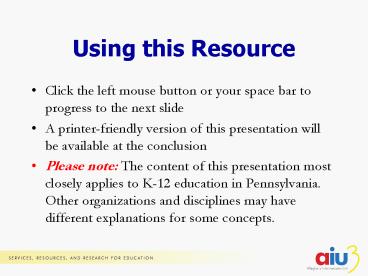Using this Resource PowerPoint PPT Presentation
1 / 23
Title: Using this Resource
1
Using this Resource
- Click the left mouse button or your space bar to
progress to the next slide - A printer-friendly version of this presentation
will be available at the conclusion - Please note The content of this presentation
most closely applies to K-12 education in
Pennsylvania. Other organizations and
disciplines may have different explanations for
some concepts.
2
Evaluation 101
- Yolanda Yugar
- Leslie Kirby
- Allegheny Intermediate Unit 3
3
Objectives
- Participants will
- Gain a basic understanding of evaluation.
- Understand the differences between evaluation,
monitoring, research. - Learn about evaluation roles (local, state,
national).
4
What is Evaluation?
- Evaluation is the process by which organizations
examine the implementation and outcomes of an
intervention to determine whether or not (and to
what extent) the intervention contributed to a
change.
5
Understanding the Differences
- Monitoring
- Checklist, Review of Documentation
- Required by Funding Agency
- Separate from the Evaluation
- Research
- Uses research methods such as control group,
well-matched comparison group, quasi-experimental
design to determine effectiveness
6
Caution The Notion of Causation
- It is common to think about a program as causing
a change. However, it is important to realize
that programs do not occur in a vacuum. A single
intervention usually cannot be the sole cause of
an effect when dealing with people. Other
programs, interventions, personal situations, and
even chance contribute to the outcomes discovered
during evaluation.
7
Evaluations are used to
- Demonstrate accountability
- Fulfill reporting requirements
- Assess needs
- Improve programs
- Determine relationship between cost and benefit
- Determine feasibility and replicability
8
Types of Evaluation
- Program implementation To what extent was the
program implemented as designed? - Program outcomes To what extent has the
initiative influenced behaviors or practices? - Program impact To what extent has the
initiative influenced student achievement?
9
Formative Evaluation
- occurs while the intervention is in progress
(usually during the developmental phase) - allows management to improve program for current
term - concentrates on implementation and feedback from
participants and/or program staff
10
Summative Evaluation
- compilation or summary of what occurred during
the intervention or a particular term, the
results of the intervention, and whether goals
were achieved - assesses overall impact
11
Mixed Method Approach
- Most evaluations use a combination of these forms
of evaluation to gain a clear understanding of
the program in order to give possible outcomes a
context. - Using more methods also allows the evaluator to
examine a single idea or portion using more
sources of data to strengthen interpretation
(triangulation).
12
Types of Data
- Participant demographics
- Participant achievement
- Processes
- Perceptions
- (adapted from Victoria Bernhardt)
13
Quantitative Data
- Quantitative data is data that can be counted or
measured. - Includes
- Assessment/test (achievement) data
- Participation and attendance rates
- Forced-choice survey questions (i.e. select
answer from a list)
14
Qualitative Data
- Qualitative data is data that cannot be easily
counted. Instead, it is used to identify themes
or trends. - Includes
- Focus group responses and Interviews
- Open-ended survey questions
- Portfolios or compilations of materials
- Observations
15
Common Evaluator Tasks
- Help staff understand evaluation and how it can
help a program plan and implement more effective
improvement activities and make corrections in
those improvement efforts when they are needed. - Develop or help to develop the overall plan for
evaluating the effort. - Involve staff in the implementation of the plan
and, if necessary, train them to carry out
specific evaluation tasks. - Help staff use specific data gathering
methods/instruments in a reliable way.
16
Common Evaluator Tasks
- Build capacity to collect, store, analyze, and
use the data to inform decision-making. - Help staff interpret data collected and make
decisions consistent with the results of specific
analyses. - Write reports that facilitate local use of the
data collected in decision-making and that
provide information. - Serve as liaison.
- Help the local effort to achieve its purposes
through the design and conduct of the evaluation.
17
Selecting an Evaluator
- You should select an evaluator who
- Reflects the needed characteristics or
requirements - Understands the organization he/she is evaluating
- Is willing to work collaboratively to identify or
develop an evaluation that meets the requirements
of the initiative and the needs of the
organization
18
Characteristics of an Evaluator
- Understands confidentiality of student data.
- Ability to develop or find appropriate assessment
instruments. - Capacity to collect, manage, analyze, and
interpret data and produce written reports based
on that data. - Capacity to guide districts in using data for
decision-making. - Understands of state and local needs.
19
Where would I find an evaluator?
- University or college
- Intermediate Unit
- Internal staff with specialized skills
- Independent contractor
- For-profit evaluation company
Your local evaluator may be one individual, or a
group of individuals, depending on the
organizations and projects needs.
20
How do I get started?
- The program and evaluator need to negotiate an
agreement that sets forth the actual role and
specific tasks for which the local evaluator will
be responsible. The agreement would delineate
how the evaluator will be compensated for his/her
services. - Rule of thumb for services is 8-10 of the total
project budget depending on the scope of services.
21
Establishing an Evaluation Team
- The team would include representation from
- Organization staff
- Program implementers
- Evaluator(s)
- Other stakeholders (community partners, funding
source, district support services, etc.)
22
Resources
- Bernhardt, V. (1998) Data Analysis for
Comprehensive School Improvement - Brainard, E. (1996) A Hands-on Guide to School
Program Evaluation - Wahlstrom, D. (2002) Using Data to Improve
Student Achievement
23
Contact
- Allegheny Intermediate Unit
- 475 East Waterfront Drive
- Homestead, PA 15120
- (412) 394-5801
- www.aiu3.net/GEDT.aspx
- www.aiu3.net/evaluations.aspx

